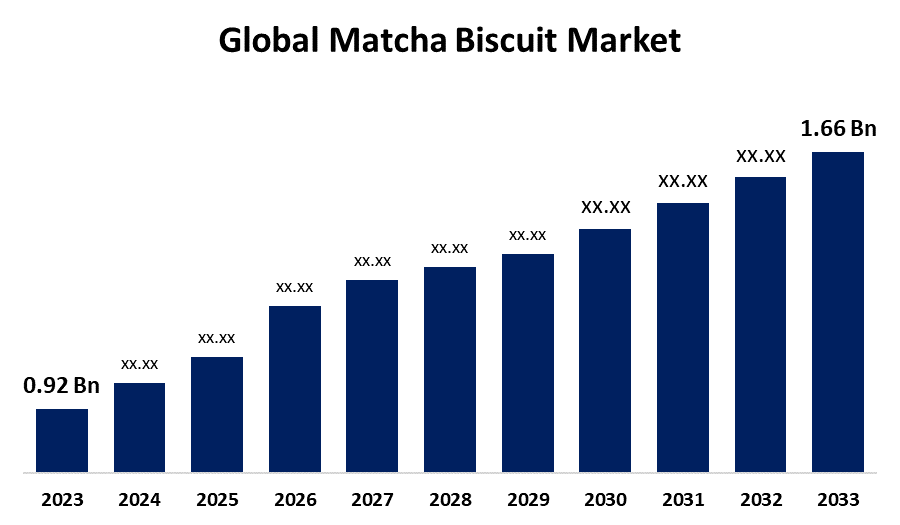Global Matcha Biscuit Market Size, Share, and COVID-19 Impact Analysis, By Product Type (Organic Matcha Biscuits, Conventional Matcha Biscuits, Gluten-Free Matcha Biscuits, Vegan Matcha Biscuits, Low-Sugar Matcha Biscuits), By Application (Household and Commercial), By Distribution Channel (Online Retail, Supermarkets/Hypermarkets, Convenience Stores, Specialty Stores), and By Region (North America, Europe, Asia-Pacific, Latin America, Middle East, and Africa), Analysis and Forecast 2023 - 2033.
Industry: Food & BeveragesGlobal Matcha Biscuit Market Insights Forecasts to 2033
- The Global Matcha Biscuit Market Size was estimated at USD 0.92 Billion in 2023
- The Market Size is Expected to Grow at a CAGR of around 6.08% from 2023 to 2033
- The Worldwide Matcha Biscuit Market Size is Expected to Reach USD 1.66 Billion by 2033
- North America is expected to Grow the fastest during the forecast period.

Get more details on this report -
The Global Matcha Biscuit Market Size was worth around USD 0.92 Billion in 2023 and is predicted to Grow around USD 1.66 Billion by 2033 with a compound annual growth rate (CAGR) of 6.08% between 2023 and 2033. The matcha biscuit market is driven by the growing demand for healthy snacks among consumers and the increase in demand for matcha as a superfood. Increasing awareness of health benefits related to matcha, including its high antioxidant levels and the possibility of increasing metabolism, serves as an important growth driver for the market. The growth of the matcha biscuit market around the world is further driven by innovations in product formulation and the expansion of distribution channels.
Market Overview
The matcha biscuits industry denotes the sector within the food industry dedicated to the production, sale, and consumption of biscuits (or cookies) flavored with matcha powder. Matcha is powdered and finely ground, specially grown leaves of green tea that have a distinctive earthy flavor and are rich green. These biscuits generally pair classic biscuit staples like flour, butter, and sugar with matcha to deliver an original and healthy eating alternative. Matcha, renowned for its dense antioxidant profile, has been embraced by healthy consumers in search of alternatives to traditional snacks. The antioxidant content of matcha comes from its concentrated green tea leaves, which makes matcha biscuits a popular choice for people who want to include healthier ingredients in their diet. The use of matcha in various food items, such as biscuits, is popular among millennials and younger generations who are more receptive to new and foreign flavors. Moreover, organic ingredient emphasis is also a big trend, with organic matcha biscuits becoming increasingly popular among the green-conscious consumer segment that likes to buy sustainably sourced products.
Report Coverage
This research report categorizes the matcha biscuit market based on various segments and regions forecasts revenue growth and analyzes trends in each submarket. The report analyses the key growth drivers, opportunities, and challenges influencing the matcha biscuit market. Recent market developments and competitive strategies such as expansion, type launch, development, partnership, merger, and acquisition have been included to draw the competitive landscape in the market. The report strategically identifies and profiles the key market players and analyses their core competencies in each sub-segment of the matcha biscuit market.
Global Matcha Biscuit Market Report Coverage
| Report Coverage | Details |
|---|---|
| Base Year: | 2023 |
| Market Size in 2023: | USD 0.92 Billion |
| Forecast Period: | 2023-2033 |
| Forecast Period CAGR 2023-2033 : | 6.08% |
| 2033 Value Projection: | USD 1.66 Billion |
| Historical Data for: | 2019-2022 |
| No. of Pages: | 220 |
| Tables, Charts & Figures: | 110 |
| Segments covered: | By Product Type, By Application, By Distribution Channel and By Region |
| Companies covered:: | Nestle S.A., ITO EN, Ltd., Unilever PLC, The Kraft Heinz Company, Mondelez International, Inc., Lotte Corporation, Meiji Holdings Co., Ltd., Ezaki Glico Co., Ltd., Morinaga & Co., Ltd., Nissin Foods Holdings Co., Ltd., Yamazaki Baking Co., Ltd., Kameda Seika Co., Ltd., and Others |
| Pitfalls & Challenges: | COVID-19 impact, Challenge, Future, Growth, & Analysis |
Get more details on this report -
Driving Factors
Matcha is seen as a functional food because it can have a health benefit to consumers, like enhancing concentration, stress reduction, and heart health. With increased consumer awareness of matcha's health benefits, the demand for matcha biscuits continues to grow. Moreover, the increasing popularity of plant-based, gluten-free, and vegan diets has presented a platform for matcha biscuits to appeal to these particular dietary needs. Most matcha biscuits are produced in gluten-free, vegan, and low-sugar forms, making them accessible to a wider consumer base further increasing the demand for matcha biscuits market.
Restraining Factors
Matcha powder, particularly premium matcha, is quite costly about other ingredients utilized in biscuit manufacturing. This raises the cost of production for matcha biscuits. Companies have to offset the price of matcha against consumer prices, which can affect profit margins and increase the final product's price for consumers deterring the demand for matcha biscuits market.
Market Segmentation
The matcha biscuit market share is classified into product type, application, and distribution channel.
- The conventional Matcha Biscuit segment dominated the market in 2023 and is projected to grow at a substantial CAGR during the forecast period.
Based on the product type, the matcha biscuit market is divided into organic matcha biscuits, conventional matcha biscuits, gluten-free matcha biscuits, vegan matcha biscuits, and low-sugar matcha biscuits. Among these, the conventional matcha biscuit segment dominated the market in 2023 and is projected to grow at a substantial CAGR during the forecast period. The growth is attributed to conventional matcha biscuits having wider appeal as they are prepared using traditional ingredients and do not specialize in any diet requirement. This makes them easily accessible to the public at large, especially where matcha is already well-received as a flavor.
- The commercial segment accounted for a significant share in 2023 and is anticipated to grow at a remarkable CAGR during the forecast period.
Based on the application, the matcha biscuit market is divided into household and commercial. Among these, the commercial segment accounted for a significant share in 2023 and is anticipated to grow at a remarkable CAGR during the forecast period. The growth is driven by commercial establishments like cafes, restaurants, and bakeries that have been adding matcha-flavored foods to respond to increasing demand for distinctive and high-end snacks. Matcha biscuits are being found in upscale cafes and specialty bakeries as they appeal to people who value novelty tastes and health-focused items.
- The supermarkets/hypermarkets segment accounted for the biggest share in 2023 and is anticipated to grow at a significant CAGR during the forecast period.
Based on the distribution channel, the matcha biscuit market is divided into online retail, supermarkets/hypermarkets, convenience stores, and specialty stores. Among these, the supermarkets/hypermarkets segment accounted for the biggest share in 2023 and is anticipated to grow at a significant CAGR during the forecast period. The segmental growth is due to supermarkets and hypermarkets providing customers with a range of matcha biscuit brands and pack sizes, appealing to single servings as well as more considerable family packs. The provision of such options increases customer purchases, thus increasing market share in this segment.
Regional Segment Analysis of the Matcha Biscuit Market
- North America (U.S., Canada, Mexico)
- Europe (Germany, France, U.K., Italy, Spain, Rest of Europe)
- Asia-Pacific (China, Japan, India, Rest of APAC)
- South America (Brazil and the Rest of South America)
- The Middle East and Africa (UAE, South Africa, Rest of MEA)
Asia Pacific is anticipated to hold the largest share of the matcha biscuit market over the predicted timeframe.

Get more details on this report -
Asia Pacific is anticipated to hold the largest share of the matcha biscuit market over the predicted timeframe. The Asia-Pacific, especially nations such as Japan, China, and South Korea, has the largest market share for matcha biscuits. Matcha is deeply rooted in the cultures of these nations, where it is used traditionally in tea ceremonies, desserts, and snacks. Since matcha is already a major aspect of everyday life and food culture, its use in biscuits is compatible with current consumer tastes.
North America is expected to grow at a rapid CAGR in the matcha biscuit market during the forecast period. North America, and specifically the United States and Canada, is experiencing the most rapid expansion in the matcha biscuits market. Consumers are increasingly looking for healthy, premium, and exotic snack foods, which matcha-based products meet because of their perceived health benefits, including antioxidants and metabolism-boosting.
Competitive Analysis:
The report offers the appropriate analysis of the key organizations/companies involved within the matcha biscuit market along with a comparative evaluation primarily based on their type of offering, business overviews, geographic presence, enterprise strategies, segment market share, and SWOT analysis. The report also provides an elaborative analysis focusing on the current news and developments of the companies, which includes type development, innovations, joint ventures, partnerships, mergers & acquisitions, strategic alliances, and others. This allows for the evaluation of the overall competition within the market.
List of Key Companies
- Nestle S.A.
- ITO EN, Ltd.
- Unilever PLC
- The Kraft Heinz Company
- Mondelez International, Inc.
- Lotte Corporation
- Meiji Holdings Co., Ltd.
- Ezaki Glico Co., Ltd.
- Morinaga & Co., Ltd.
- Nissin Foods Holdings Co., Ltd.
- Yamazaki Baking Co., Ltd.
- Kameda Seika Co., Ltd.
- Others
Key Target Audience
- Market Players
- Investors
- End-users
- Government Authorities
- Consulting And Research Firm
- Venture capitalists
- Value-Added Resellers (VARs)
Market Segment
This study forecasts revenue at global, regional, and country levels from 2023 to 2033. Spherical Insights has segmented the matcha biscuit market based on the below-mentioned segments:
Global Matcha Biscuit Market, By Product Type
- Organic Matcha Biscuits
- Conventional Matcha Biscuits
- Gluten-Free Matcha Biscuits
- Vegan Matcha Biscuits
- Low-Sugar Matcha Biscuits
Global Matcha Biscuit Market, By Application
- Household
- Commercial
Global Matcha Biscuit Market, By Distribution Channel
- Online Retail
- Supermarkets/Hypermarkets
- Convenience Stores
- Specialty Stores
Global Matcha Biscuit Market, By Regional Analysis
- North America
- US
- Canada
- Mexico
- Europe
- Germany
- UK
- France
- Italy
- Spain
- Russia
- Rest of Europe
- Asia Pacific
- China
- Japan
- India
- South Korea
- Australia
- Rest of Asia Pacific
- South America
- Brazil
- Argentina
- Rest of South America
- Middle East & Africa
- UAE
- Saudi Arabia
- Qatar
- South Africa
- Rest of the Middle East & Africa
Frequently Asked Questions (FAQ)
-
1. What is the CAGR of the matcha biscuit market over the forecast period?The global matcha biscuit market is projected to expand at a CAGR of 6.08% during the forecast period.
-
2. What is the market size of the matcha biscuit market?The global matcha biscuit market size is expected to grow from USD 0.92 Billion in 2023 to USD 1.66 Billion by 2033, at a CAGR of 6.08% during the forecast period 2023-2033.
-
3. Which region holds the largest share of the matcha biscuit market?Asia Pacific is anticipated to hold the largest share of the matcha biscuit market over the predicted timeframe.
Need help to buy this report?